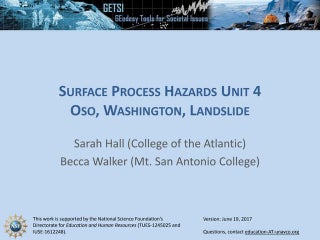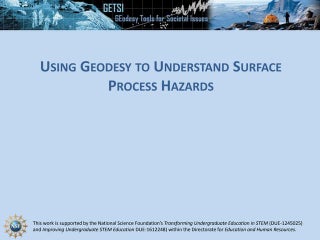Unit 4: Anatomy of a tragic slide: Oso Landslide case study
Summary
Landslides can have profound societal consequences, such as did the slide that occurred near Oso, Washington in 2014. Forty-three people were killed and entire rural neighborhood was destroyed. In this unit, students consider the larger-scale tectonic and climatic setting for the landslide and subsequently use lidar and SRTM (Shuttle Radar Topography Mission) hillshade images, topographic maps, and InSAR (interferometric synthetic aperture radar) to determine relationships between landscape characteristics and different types of mass-wasting events. They conclude by considering the societal costs of such a disaster and ways that communities in similar situations may mitigate their risk.
Learning Goals
Unit 4 Learning Outcomes
- Students will identify several environmental characteristics of a natural landscape that increase an area's mass-wasting susceptibility.
- Students will create a map with appropriate symbology illustrating the morphological characteristics of a mass-wasting event.
- Students will use geodetic data to compare the appearance, existence, and morphology of surface features before and after a mass-wasting event.
- Students will be able to describe the societal toll that landslides can cause and propose mitigation solutions.
Unit 4 Teaching Objectives
- Cognitive: Provide opportunities for students to use climate and geodetic data to characterize the evolution of landscape features after a mass-wasting event has occurred.
- Behavioral: Facilitate student ability to qualitatively assess and map the changes in geomorphic features before and after a mass-wasting event.
- Affective: Facilitate student ability to analyze the societal impact of mass-wasting events.
Context for Use
The content in Unit 4 is appropriate for introductory geology, hazards, and other geoscience courses; sophomore-level courses in which geodesy and/or geomorphology/surface processes are being introduced; or non-geoscience courses where infrastructure planning, Earth hazards, and/or the nature and methods of science are being investigated. Unit 4 activities can be adapted to serve small or large-enrollment classes and can be executed in lecture and lab settings as an in-class activity in which students work in small groups, a lab exercise, or as part of a ~2 week investigation of the use of geodesy to understand surface-process hazards and decision making using the entire Surface Process Hazards module.
This unit precedes Unit 5: Mitigating future disasters—developing a mass-wasting hazard map in which students create a hazard map and report on an area susceptible to mass wasting. If the entire two-week module will not be used, we recommend pairing Unit 4 with Unit 5 to give students the opportunity to use geodetic data to identify landscape features associated with a slow-slip mass-wasting event and classify low, medium, and high-risk areas based on landscape characteristics. However, Unit 4 does build on skills from Unit 2: Reading the landscape and Unit 3: Understanding landslide factors so you may need to have to give some background practice or information on these topics.
Description and Teaching Materials
Part 1: Preparatory activity
- In each of the five study sites that students have looked at in Units 2 and 3, there is a significant mass wastage somewhere in the map area. In order to prepare for Unit 4, have students prepare five-minute presentations on one those mass-wastage events (except the Northern Washington one, as the rest of Unit 4 is about the Oso Landslide in that region). If you have a large class, you may want to have the students work in groups or randomly select one person/team from each of the four sites to present. This process helps students understand more about the societal cost of mass wasting and the different types of ones that can occur.
- Unit 4 preparation student exercise (Microsoft Word 2007 (.docx) 201kB Aug22 24)
- Scientific references - this prep exercise calls for students to find scientific articles about the landslide events. If this type of research is not something that works well for your students, here are some links you could give them. It may also help them to refer to the USGS Landslide Fact Sheet.
- Tully, NY
- Thistle, UT
- USGS: Report of the Thistle Slide
- Utah Geological Survey: Geosights: Thistle Landslide Revisited
- Kelso, WA
- Prince William Sound, AK
- AK Dept of Fish & Game: [link https://pubs.er.usgs.gov/publication/70168586 Part 2: Setting the stage 'A submarine landslide source for the devastating 1964 Chenega tsunami, southern Alaska']
- Earthquake, Landslide and Tsunami Hazards in the Port Valdez area, Alaska
In order to place the Oso Landslide in a larger geologic context, students will review the environmental and built characteristics of the northwest Washington locality using the maps from Units 2 and 3.
A) Plate tectonic setting
Seismic and volcanic hazards exist along all of eastern Washington state related to the subduction of the Juan de Fuca Plate beneath the North American Plate. This is a good opportunity to relate the plate tectonic setting to the landscape features (faults, linear ridges/streams, mountains) and present hazards. Use the same map-set for Northern Washington as you did in Unit 3.
Northern Washington Maps Unit 3-4 (Acrobat (PDF) 41.3MB Oct22 20)
We suggest one of the following already-existing plate tectonics activities:
- GPS Data and Earthquake Hazards in Cascadia - Students learn to read GPS timeseries to calculate velocities and then analyze what the changing velocity across Cascadia means for earthquake hazard.
- Analyzing Plate Motion Using EarthScope GPS Data - Student use a spreadsheet of GPS data from the Plate Boundary Observatory (PBO) to measure the motion of GPS stations in the Pacific Northwest. They generate and map annual velocity vectors of GPS stations.
B) Climatic setting
Washington state has an excellent example of high-precipitation region and a rain shadow. High seasonal precipitation focused on the western slopes of the Cascades and arid conditions prevailing over eastern Washington. In this activity students looks at climate data from near Oso, Washington, as well as a precipitation map of Washington to learn more about the general climate of the area as well as in the time leading up to the slide itself.
- Washington precipitation map (Acrobat (PDF) 1.2MB Feb25 16)
- Unit 4: Oso Washington climate assessment student exercise (Microsoft Word 2007 (.docx) 253kB Aug22 24)
Unit 4: Oso Washington climate assessment student exercise PDF (Acrobat (PDF) 302kB Aug22 24)
Part 3. Mass-wasting anatomy—Oso, WA, Case Study
Along with the assignment below and the map set they have already used, students should be given a lidar hillshade image onto which they will identify, map, and label morphological features of the mass-wasting event. They will answer qualitative questions and will color code their maps to show regions of high/moderate/low risk for damage due to slip. Students will then be shown spatial data of the region at various timesteps (including SRTM [Shuttle Radar Topography Mission], lidar, and InSAR maps of the locality) and answer questions related to the geology and societal impacts of the event.
- Unit4: Oso Introduction Presentation (PowerPoint 2007 (.pptx) 8.8MB Jun20 17)
- Northern Washington Maps Unit 3-4 (Acrobat (PDF) 41.3MB Oct22 20)
- Unit 4 Oso Landslide Exercise (Microsoft Word 2007 (.docx) 34MB Aug22 24)
Unit 4 Oso landslide exercise PDF (Acrobat (PDF) 16.4MB Aug22 24)
Teaching Notes and Tips
- If you have not already and would like to give your students a little more context about geodesy data in general and the lidar and InSAR methods in particular, you could use this short presentation.
Introduction to Geodesy and Surface Process Hazards Presentation (PowerPoint 2007 (.pptx) 14.7MB Aug21 24) - This unit seems to go forward in a pretty straightforward way. Although it takes a little extra time, we really do recommend the brief student presentations in Part 1. If students have never done PowerPoint presentations (or other presentation software), you may need to spend a little time explaining what to do or give guidance on what each slide should contain.
Assessment
Formative Assessment
Most likely, formative assessment will be gathered through discussion with students and observation of students as they work through the exercise. By monitoring classroom activity, the instructor can gauge how students are progressing toward the learning outcomes.
Summative Assessment
The primary summative assessment for the module is the Oso Landslide Exercise. In addition, in order to assess whether students have achieved a sufficient understanding of the societal side of the unit, one of the following questions could be used on a test.
Level 2: Besides the mass of material that buried the town, the Oso mass-wasting event left a mark on the geographic and societal landscape both locally and regionally. Students will be asked to answer the following questions:
- Name and describe two examples of a local indirect effect of the Oso mass-wasting event—near to the town of Oso.
- Name and describe two examples of a regional indirect effect of the Oso mass-wasting event—downstream of the event?
Level 3: Students will research what has been done to plan for the future in the aftermath of the Oso event. They will prepare a one-page narrative describing how the community and/or state is working to prevent or preparing for the future in this landslide-prone region.
References and Resources
- Jin-Woo Kim, Zhong Lu, Feifei Qu & Xie Hu (2015) Pre-2014 mudslides at Oso revealed by InSAR and multi-source DEM analysis, Geomatics, Natural Hazards and Risk, 6:3, 184-194, DOI: 10.1080/1947705.2015.1016556
- Haugerud, R. A. (2014) Preliminary Interpretation of Pre-2014 Landslide Deposits in the Vicinity of Oso, Washington, USGS Open-File Report 2014–1065
- USGS Follow-up March 2015: One Year Later—The Oso Landslide in Washington.
- Wikipedia Oso Mudslide
- Introduction to Geodesy and Surface Process Hazards Presentation (PowerPoint 2007 (.pptx) 14.7MB Aug21 24)
- https://www.oregongeology.org/Landslide/Landslidehome.htm
- http://www.seattle.gov/dpd/aboutus/whoweare/emergencymanagement/
- http://www.portlandoregon.gov/pbem/53935
- http://landslides.usgs.gov/
- http://landslides.usgs.gov/learn/prepare.php
- http://pubs.usgs.gov/circ/1325/




![[reuse info]](/images/information_16.png)










